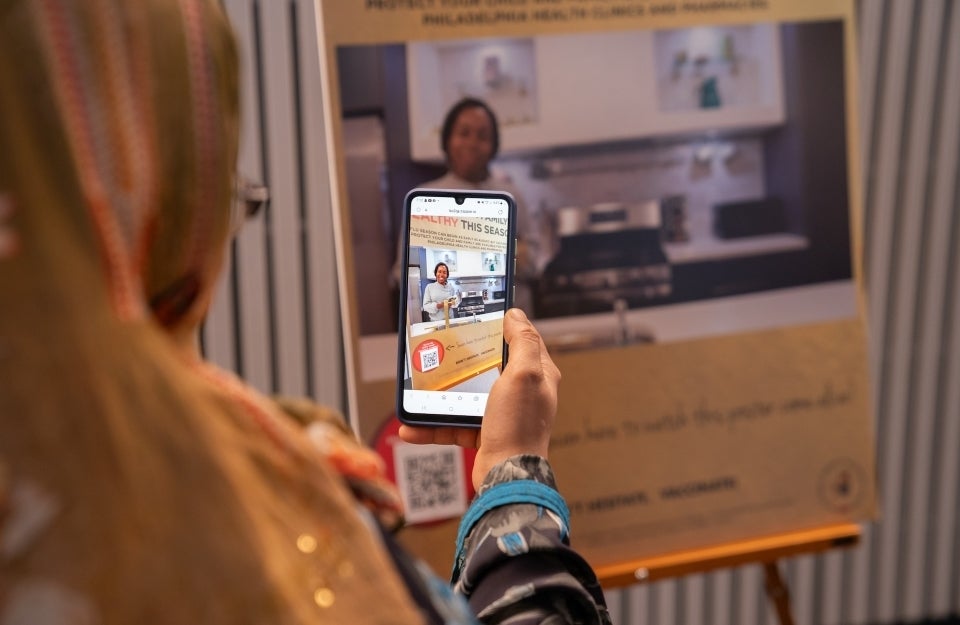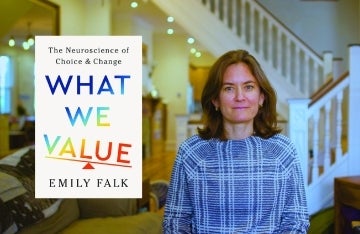Researchers Use Augmented Reality to Encourage Pediatric Vaccination In Philadelphia
Researchers at Penn, including the co-directors of the Annenberg Extended Reality Lab, worked with members of the West Philadelphia community to co-create AR health campaigns about pediatric vaccination.

At a virtual reality showcase, West Philadelphia community members tested augmented reality posters created by the Annenberg Extended Reality Lab and Penn Nursing.
A new study from the University of Pennsylvania is shedding light on how augmented reality (AR) can be used to build trust amongst vaccine-hesitant members of the public and educate them about the importance of pediatric flu vaccines.
The Centers for Disease Control and Prevention (CDC) recommends that everyone aged 6 months and older receive a COVID-19 vaccine and a flu vaccine. However, misinformation persists about the COVID-19 and flu vaccinations.
To build trust and encourage vaccination, the research team — Annenberg School for Communication Extended Reality Lab Co-Directors Katerina Girginova (Ph.D. ‘19) and Kyle Cassidy, Penn Nursing faculty Terri Lipman and Melanie Kornides, Penn Medicine Virtual Reality & Artificial Intelligence Lab Director Jeffrey Vadala, Annenberg Professor Andy Tan, and Annenberg doctoral student Kate Okker-Edging — worked with parents, guardians, and youth in West Philadelphia to create AR campaigns to share information about influenza and COVID-19 vaccinations.
Co-Creating Health Campaigns
With the help of West Philadelphians interested in educating friends and neighbors about childhood vaccination, the research team created posters and postcards printed with QR codes, leading users to different AR videos and experiences.
“We wanted this campaign to feel as authentic as possible, so we spent over a year working with community members to build and refine our messaging,” Girginova says. “Using augmented reality was a natural fit for the delivery of our content because it has the unique capacity to be integrated within a person’s surroundings, adding to our efforts to connect with local communities.”
When a person scans the QR code with their phone, the poster or postcard “comes alive” with a short video sharing the importance of pediatric vaccination over the poster. Users can also access a map of the closest vaccination clinics based on their location.

Based on community feedback, the team created short, lighthearted videos dedicated to highlighting the importance of pediatric vaccination.
“We went with a humorous approach to our campaign because research shows that using humor helps to connect with vaccine-hesitant communities,” says Cassidy. “Our actors are all extremely accomplished professionals with amazing resumes who know how to both craft and deliver comedic lines that made our audiences smile. Many of them are also West Philadelphia residents and parents, adding further to the authenticity of our work.”
Multiple posters and postcards were created for each campaign, some for the COVID-19 vaccine and others for the flu vaccine, and placed in different locations in Philadelphia.
The flu vaccine campaigns also included an interactive game. In the game, an animated cartoon of the flu virus floated around the user’s environment, and a user could win the game by correctly answering questions about the virus.
Connection Through Technology
The researchers hope that this work will pave the way for more initiatives in healthcare and public health communication and encourage researchers to consider how AR and other immersive technologies can be used ethically and effectively in public health messaging.
“We are continuing our research on augmented reality media because we see much potential in the way it can connect people, content, and places in an effort to make messaging more personal, impactful, and likely to inspire real action,” Girginova says. “Plus, the barrier to entry is quite low as many people around the world now have smartphones.”
“Augmented Landscapes of Empathy: Community Voices in Augmented Reality Campaigns” was published in Media and Communication and authored by Katerina Girginova, Jeffrey Vadala, Andy Tan, Kate Okker-Edging, Kyle Cassidy, Terri Lipman, and Melanie Kornides



